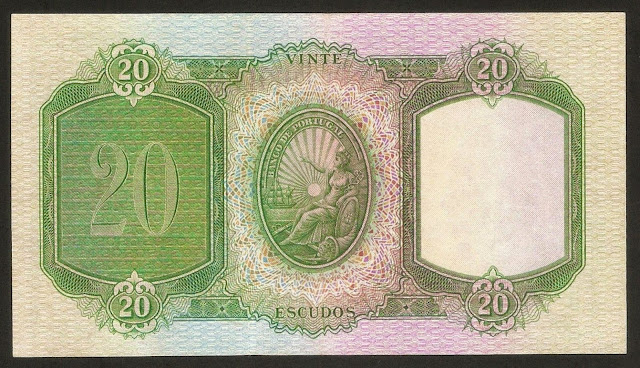Portugal Banknotes 20 Escudos banknote 1941 António Luís de Meneses, 1st Marquis of Marialva
Bank of Portugal - Banco de Portugal
Obverse: Portrait of António Luís de Meneses, 1st Marquis of Marialva at right.
Reverse: The original seal of Banco de Portugal.
Printer: Bradbury, Wilkinson & Co. Ltd., New Malden, Surrey England.
Watermark: Portrait of António Luís de Meneses, 1st Marquis of Marialva.
Size: 135 x 76 mm
First Issue: 19 December 1941
Last Issue: 02 January 1962
Withdrawn from circulation: 30 June 1978.
Old Portuguese banknotes
1941-1959 "Chapa 6 & 6A" Issue - 1942 "Chapa 1 & 7" Issue
António Luís de Meneses, 1st Marquis of Marialva
António Luís de Meneses, 1st Marquis of Marialva and 3rd Count of Cantanhede (December 13, 1603 – August 1675) was a member of the Forty Conspirators and a Portuguese general who fought in the Portuguese Restoration War, that ended the Iberian Union between Portugal and Spain.
Meneses was born in a noble family - his father was Dom Pedro de Menezes, 2nd count of Cantanhede, and his mother Dona Constança de Gusmão (daughter of Rui Gonçalves da Câmara, 1st count of Vila Franca).
Meneses was one of the key conspirators in the revolt against the Spanish Habsburgs on December 1, 1640. He took active part in the storming of the residence and the capture of the Duchess of Mantua, who governed Portugal in the name of Philip IV of Spain (Philip III of Portugal). In 1641 he was assigned as general-commander (mestre-de-campo) of the Portuguese forces loyal to John IV of Portugal, and he organized the defences against Spanish attacks. He participated in almost every battle of the Portuguese Restoration War between 1641 and 1665. His greatest victories were the Battle of the Lines of Elvas in 1659 and the Battle of Montes Claros in 1665. After the success in the first battle the Count of Cantanhede received among several honors, the title of Marquis of Marialva on June 11, 1661. He was present at the signing of the Treaty of Lisbon on February 13, 1668.
His political career after the war was not as successful, and, in the end sources state that he was poor and committed suicide in Cantanhede in 1675. He was buried in the Convent of Santo António in the same town.
The original seal of Banco de Portugal
In 1846, Banco de Portugal adopted, with slight changes, the white seal that painter Domingos Sequeira had created for Banco de Lisboa.
The design reflects the classical universe of the time and contains a large variety of allegorical items alluding to fiduciary wealth, financial health and prudence, the Discoveries and trade.
Oval in shape, the seal depicts a goddess, resting upon a shield with reference to the Royal Decree that created Banco de Portugal.
The goddess is clad in long clothes and Greek sandals and wears a caravel-shaped diadem. Her right arm stretches towards the horizon. On her left arm, she holds a caduceus entwined with two serpents and an eagle, symbolising financial wealth and prudence and royal power.
The goddess is surrounded by a cornucopia of coins (symbolising fiduciary wealth), an anchor, the sea and a ship (allusive of the Discoveries and trade), and the sun, beneath the wording “Banco de Portugal”.

